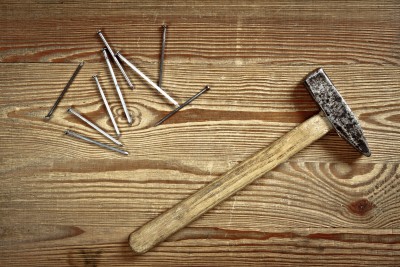<p>The commonest tools for cutting and shaping masonry of all types are cold chisels. There are several general-purpose and specific versions.</p>
<p>The flat-cut cold chisel is frequently used on masonry for splitting, chopping out, cutting chases and, occasionally, rough shaping. Like the rest of the cold chisel family, it is a hexagonal steel bar with a cutting tip formed at one end &#8211; in this case a straightforward wedge-shaped tip a little wider than the bar. The other end has chamfered edges to prevent chipping when struck with a heavy hammer.</p>
<p>The cross-cut cold chisel also known as the Cape chisel, has a cutting edge very much narrower than the bar from which it is made, allowing it to cut slots and grooves with great accuracy.</p>
<p>The half-round cold chisel is a variation of the cross-cut chisel and may also be known as the round-nosed chisel. Used mainly for cutting grooves, it can produce rounded internal corners as well.</p>
<p>The diamond-point cold chisel is yet another variation of the crosscut chisel and is sometimes known as the diamond-cut chisel. It has a diagonally-ground single cutting bevel Use it for making V-shaped grooves and neatly angled internal corners.</p>
<p>The plugging chisel is otherwise known as the seaming chisel or seam drill. It has a curious slanting head, and is used for removing the mortar pointing in brickwork. Two types are available: one with a plain head and the other with a flute cut into the side to help clear waste material.</p>
<p>The concrete point is a fairly rare cold chisel that tapers to a point rather than a normal cutting edge and is used for shattering concrete or brickwork in areas previously outlined with a flat chisel.</p>
<p>The dooking iron is intended for cutting holes through brickwork and stone. This extra-long, flat-cut cold chisel has a narrow &#8216;waist&#8217; let into the bar just behind the head to help prevent waste from jamming it in the masonry.</p>
<p>The brick bolster has a extra-wide, spade-shaped head and is designed to cut bricks cleanly in two. Most have a 100mm (4in) wide cutting edge, but other widths can be found, and care should be taken not to confuse these with other types of bolster chisel such as the mason&#8217;s bolster or even the floorboard chisel. They are not tempered in the same way and may be damaged if used incorrectly</p>
<p>The mason&#8217;s chisel comes in two varieties. Narrow versions look like ordinary cold chisels, but the wider versions are more like brick bolsters. They are intended for general shaping and smoothing of stonework. The very narrow types (sometimes called edging-in chisels) are used to make a starting groove for a bolster when splitting large blocks and slabs.</p>
<blockquote><p><em>Crystal has written this article for Conlin Premier Construction, a deck builder in peterborough offering construction services since last 30 years.</em></p></blockquote>

Appropriate Tools for Cutting and Shaping Masonry
